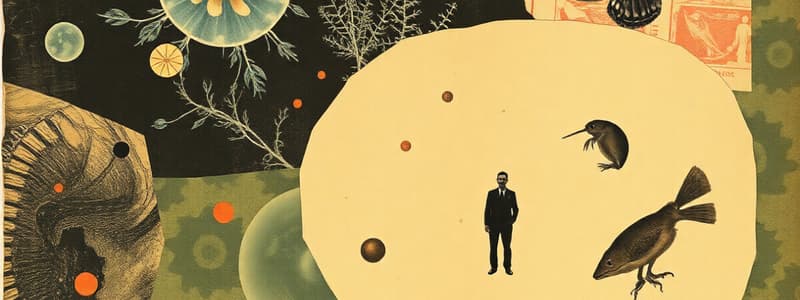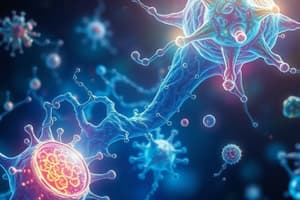Podcast
Questions and Answers
Which of the following characteristics is NOT associated with living things?
Which of the following characteristics is NOT associated with living things?
- Reproduction
- Excretion
- Respiration (correct)
- Nutrition
What structure in plant cells is responsible for photosynthesis?
What structure in plant cells is responsible for photosynthesis?
- Chloroplasts (correct)
- Vacuole
- Cell Wall
- Cytoplasm
Which group of living things includes only organisms that do not have a backbone?
Which group of living things includes only organisms that do not have a backbone?
- Invertebrates (correct)
- Fungi
- Bacteria
- Vertebrates
What is the primary function of the cell membrane in both animal and plant cells?
What is the primary function of the cell membrane in both animal and plant cells?
How do living things primarily obtain energy from their environment?
How do living things primarily obtain energy from their environment?
Which statement correctly describes the nucleus in a cell?
Which statement correctly describes the nucleus in a cell?
What distinguishes vertebrates from invertebrates?
What distinguishes vertebrates from invertebrates?
Which of the following is a likely function of the vacuole in plant cells?
Which of the following is a likely function of the vacuole in plant cells?
Which living organism is considered a prokaryote?
Which living organism is considered a prokaryote?
What feature is unique to animal cells compared to plant cells?
What feature is unique to animal cells compared to plant cells?
Flashcards
Living things
Living things
Organisms that exhibit the following characteristics: cells, nutrition, excretion, response, and reproduction.
Cells
Cells
The basic building blocks of all living things.
Nutrition
Nutrition
The way living things obtain food.
Excretion
Excretion
Signup and view all the flashcards
Animal cells
Animal cells
Signup and view all the flashcards
Plant cells
Plant cells
Signup and view all the flashcards
Cell membrane
Cell membrane
Signup and view all the flashcards
Nucleus
Nucleus
Signup and view all the flashcards
Cytoplasm
Cytoplasm
Signup and view all the flashcards
Chloroplasts
Chloroplasts
Signup and view all the flashcards
Study Notes
Living Things and Cells
- Living things are different from non-living things.
- Living things have characteristics:
- Cells: Basic building blocks of living things
- Nutrition: The way living things get food
- Excretion: The way living things get rid of waste
- Response: How living things react to changes
- Reproduction: The way living things produce new living things.
Groups of Living Things
- Bacteria: Tiny microscopic living things
- Fungi: Mushrooms, molds, and yeast
- Plants: Trees, grasses, and flowers
- Animals: Humans, fish, insects, etc.
- Others: Seaweeds, amoeba
- Vertebrates: Animals with backbones (e.g., horse, seagull, frog, snake)
- Invertebrates: Animals without backbones (e.g., spider, earthworms, fly, jellyfish)
Cells
- Living things are made of cells.
- Animal Cells:
- Membrane: Holds cell contents, controls what enters/exits
- Nucleus: Control center of the cell
- Cytoplasm: Carries out cell reactions, supports structures
- Plant Cells:
- Cell Wall: Gives strength to the cell
- Cell Membrane: Controls what enters/exits the cell
- Nucleus: Control center
- Cytoplasm: Carries out cell reactions, supports structure
- Chloroplasts: in plant cytoplasm, tiny structures that make food via photosynthesis
- Vacuole: Gives strength to the cell
Studying That Suits You
Use AI to generate personalized quizzes and flashcards to suit your learning preferences.




